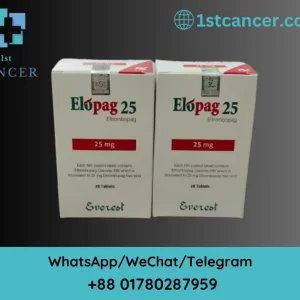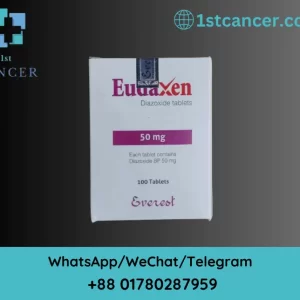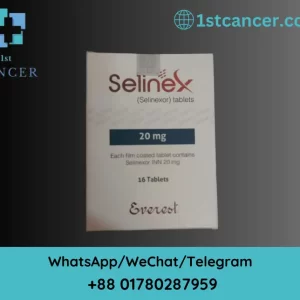Healthcare professionals use Tofacitinib (Tofacent), marketed as Tofacent, to treat certain autoimmune conditions, such as rheumatoid arthritis, psoriatic arthritis, ulcerative colitis, and other related inflammatory diseases.
Tofacitinib (Tofacent) is a Janus kinase (JAK) inhibitor. Tofacitinib blocks certain enzymes (JAKs) involved in immune system signaling to reduce inflammation. Healthcare professionals use tofacitinib to manage symptoms and slow the progression of conditions like rheumatoid arthritis and psoriatic arthritis, reducing joint pain,

swelling, and stiffness. Tofacitinib (brand name Tofacent) actively treats ulcerative colitis by diminishing inflammation in the digestive tract. Typically, healthcare providers administer Tofacitinib in tablet form orally, adjusting dosages and administration based on the specific condition being treated and the individual patient’s response.
Common side effects of tofacitinib might include upper respiratory tract infections, headache, diarrhea, and high blood pressure. Serious side effects may include an increased risk of infections, liver problems, and an increased risk of blood clots.
As medical information can change due to ongoing research and updates, it’s essential to consult a healthcare professional or refer to the most recent prescribing information and resources for the latest and most detailed information about Tofacitinib (Tofacent), including its usage, potential side effects, and any precautions associated with its use.
Introduction of Tofacitinib (Tofacent):
In the realm of rheumatoid arthritis (RA) treatment, the landscape is continually evolving, with researchers and medical professionals tirelessly seeking innovative solutions to alleviate the burden of this chronic autoimmune condition. Amidst this quest for advancements, Tofacitinib has emerged as a beacon of hope, offering a novel approach to managing the complexities of RA.
Tofacitinib, a Janus kinase (JAK) inhibitor, stands at the forefront of a new wave of therapeutic options for RA patients, challenging traditional norms and providing a fresh perspective on disease management. As we delve into the intricacies of Tofacitinib, this article aims to unravel its mechanism of action, explore its clinical efficacy, and shed light on the transformative impact it has had on the lives of individuals grappling with the challenges posed by rheumatoid arthritis.
As we navigate through the details of Tofacitinib, it becomes evident that this medication is not merely a pharmaceutical intervention; it symbolizes a paradigm shift in how we approach and treat rheumatoid arthritis. Join us on this journey to understand the science behind Tofacitinib and its implications for the future of RA therapeutics.
Background of Tofacitinib (Tofacent):
In the relentless pursuit of effective treatments for rheumatoid arthritis (RA), Tofacitinib emerges as a revolutionary player, breaking away from conventional norms and offering a glimmer of hope for those grappling with the debilitating impacts of this autoimmune disorder.
Tofacitinib belongs to the class of Janus kinase (JAK) inhibitors, a family of drugs designed to target the intricate signaling pathways implicated in the immune response. The genesis of Tofacitinib lies in the understanding that RA is not merely a joint-centric affliction but a systemic immune dysregulation, necessitating a nuanced therapeutic approach.
Approved by regulatory authorities in recent years, Tofacitinib has swiftly risen to prominence due to its unique mechanism of action. Unlike traditional disease-modifying antirheumatic drugs (DMARDs) that predominantly act on downstream inflammatory processes, Tofacitinib interrupts the signaling cascade at the source by inhibiting specific JAK enzymes. These enzymes play a pivotal role in the activation of immune cells, and by tempering their activity, Tofacitinib curtails the relentless assault on the synovium characteristic of RA.
The clinical journey of Tofacitinib has been marked by rigorous trials and meticulous evaluations. Its efficacy has been demonstrated not only in alleviating the symptoms of RA but also in retarding the progression of joint damage—a critical aspect in preserving the long-term functionality of individuals affected by this chronic condition.
As we navigate the background of Tofacitinib, it is essential to appreciate the transformative potential it holds. Beyond symptomatic relief, Tofacitinib opens avenues for a more personalized and targeted approach to RA treatment, heralding a new era in the management of autoimmune disorders. Join us as we delve deeper into the science behind Tofacitinib and unravel the threads that weave its compelling narrative in the tapestry of rheumatoid arthritis therapeutics.
Mechanism of Action Tofacitinib (Tofacent):
Tofacitinib, a beacon of innovation in rheumatoid arthritis (RA) therapeutics, owes its efficacy to a meticulously orchestrated mechanism of action that directly targets the core of immune dysregulation. Positioned as a Janus kinase (JAK) inhibitor, Tofacitinib operates at the molecular crossroads of inflammatory signaling pathways, disrupting the intricate dance that fuels the relentless assault on joints characteristic of RA.
At the heart of Tofacitinib’s mechanism lies the inhibition of specific JAK enzymes, namely JAK1 and JAK3. These enzymes are instrumental in transmitting signals within the immune system, orchestrating the activation and proliferation of immune cells. By selectively impeding JAK1 and JAK3, Tofacitinib puts the brakes on this signaling cascade, interrupting the aberrant immune response that wreaks havoc on the synovium.
In practical terms, when Tofacitinib enters the scene, it acts as a sentinel, standing guard at the entrance of the immune system’s command center. It selectively blocks the signals that drive the activation of T cells, B cells, and other key players in the immune orchestra. This deliberate interference doesn’t suppress the entire immune system, but rather modulates it with a precision akin to fine-tuning an instrument.
Beyond this orchestration at the cellular level, Tofacitinib’s influence extends to the realm of cytokines.
the messengers that amplify and sustain the inflammatory response. By impeding JAK pathways, Tofacitinib indirectly curtails the production of pro-inflammatory cytokines, further dampening the inflammatory milieu within the joints.
This dual-pronged approach—the precise inhibition of JAK enzymes coupled with the downstream modulation of cytokines—makes Tofacitinib a formidable contender in the arsenal against RA. Its mechanism of action not only addresses the symptoms but also intervenes at the root of the disease, offering a level of therapeutic precision that marks a paradigm shift in the treatment landscape. As we unravel the intricacies of Tofacitinib’s molecular ballet, we gain insights into a therapeutic strategy that holds promise in reshaping the narrative of rheumatoid arthritis management.
Clinical Uses of Tofacitinib (Tofacent):
In the realm of rheumatoid arthritis (RA), Tofacitinib stands as a versatile and potent agent, ushering in a new era of therapeutic possibilities. Its clinical uses extend beyond mere symptom alleviation, reaching into the core of autoimmune dysregulation and signaling a departure from traditional approaches.
-
RA Symptom Management:
- Tofacitinib’s primary clinical role lies in the effective management of RA symptoms. From the stifling pain to the debilitating joint stiffness, Tofacitinib steps into the fray, offering relief by curbing the overactive immune response that characterizes RA. As a disease-modifying antirheumatic drug (DMARD), Tofacitinib not only tackles symptoms but also aims to impede the progression of joint damage.
-
Monotherapy and Combination Therapy:
- The adaptability of Tofacitinib shines in its capacity to be used as both monotherapy and in combination with other DMARDs. Whether as a standalone intervention or paired with methotrexate, Tofacitinib proves its efficacy, providing physicians with a flexible tool to tailor treatments according to the unique needs of each patient.
-
Biologic-Experienced Patients:
- Tofacitinib steps into the spotlight for patients who have previously experienced inadequate responses to biologic DMARDs. This positions it as a valuable alternative, offering a different mechanism of action that might resonate more effectively with certain individuals, expanding the therapeutic repertoire for those navigating the challenges of treatment resistance.
-
Psoriatic Arthritis:
- Beyond its role in RA, Tofacitinib demonstrates clinical efficacy in the realm of psoriatic arthritis—a condition entwined with both joint inflammation and skin manifestations. This dual-action prowess makes Tofacitinib a compelling option for individuals grappling with the complexities of psoriatic arthritis.
-
Ulcerative Colitis:
- Tofacitinib’s impact extends even further, making strides in the management of ulcerative colitis, a form of inflammatory bowel disease. By tempering the immune response in the gastrointestinal tract, Tofacitinib showcases its versatility, transcending the boundaries of traditional autoimmune domains.
In the evolving landscape of autoimmune therapeutics. Tofacitinib not only addresses the symptoms but offers a tailored, precision-based approach to disease management. As we navigate the clinical terrain, it becomes evident that Tofacitinib is not confined to a single role. It is a dynamic force reshaping the contours of treatment strategies. Opening doors to new possibilities for patients and practitioners alike.
Clinical Trials and Research of Tofacitinib (Tofacent):
Tofacitinib, is a pioneering force in the treatment landscape of rheumatoid arthritis (RA). Owes its standing not only to its clinical success but also to a robust foundation built upon rigorous clinical trials and groundbreaking research endeavors. The scientific odyssey of Tofacitinib unfolds as a testament to its journey from conceptualization to clinical application.
-
Phase III Trials:
- Tofacitinib’s ascent to prominence gained momentum through a series of Phase III clinical trials, where its safety and efficacy were meticulously scrutinized. These trials, involve a diverse spectrum of RA patients. Demonstrated the drug’s ability to significantly reduce the signs and symptoms of RA, paving the way for regulatory approvals.
-
ORAL Start and Standard Trials:
- The landmark ORAL Start trial compared Tofacitinib as monotherapy and in combination with methotrexate against methotrexate alone. The results not only affirmed Tofacitinib’s effectiveness but also showcased its viability as a standalone option. The ORAL Standard trial further delved into Tofacitinib’s role as a DMARD, affirming its disease-modifying potential.
-
Long-Term Extension Studies:
- Tofacitinib’s journey extended beyond the confines of initial trials through long-term extension studies. These investigations provided valuable insights into the drug’s sustained efficacy and safety over extended periods. Addressing concerns related to the durability of therapeutic benefits and potential adverse effects.
-
Comparative Effectiveness Research:
- Comparative effectiveness research positioned Tofacitinib against conventional DMARDs and biologics, unraveling its place in the treatment algorithm. These studies are often head-to-head comparisons. Elucidated Tofacitinib’s relative merits and its potential as a compelling alternative for patients with varying profiles and treatment histories.
-
Real-World Evidence:
- The transition from controlled trials to real-world scenarios is a critical juncture for any therapeutic agent. Tofacitinib’s performance in diverse patient populations. Reflecting the intricacies of clinical practice has been under the scrutiny of real-world evidence studies. These investigations contribute to a comprehensive understanding of Tofacitinib’s practical implications beyond the controlled settings of clinical trials.
-
Expanding Horizons:
- Tofacitinib’s impact isn’t confined to RA alone. Ongoing research explores its efficacy in diverse autoimmune conditions, such as psoriatic arthritis and ulcerative colitis. This expansion of horizons reflects the dynamic nature of Tofacitinib research, pushing boundaries and exploring novel avenues in autoimmune care.
As Tofacitinib’s scientific narrative continues to unfold. It reaffirms its position as a trailblazer in RA therapeutics. Underpinned by a wealth of evidence from clinical trials and ongoing research initiatives. The journey from bench to bedside epitomizes a commitment to scientific excellence. Shaping the future landscape of autoimmune treatment through the lens of Tofacitinib’s transformative potential.
Navigating Potential Side Effects of tofacitinib (Tofacent):
While Tofacitinib stands as a beacon of hope in the realm of rheumatoid arthritis (RA) treatment. Its efficacy is accompanied by a nuanced landscape of potential side effects. As with any therapeutic intervention, it is crucial for patients and healthcare providers to be well-informed about these potential risks. Ensuring a balanced perspective on the use of Tofacitinib in the management of RA.
-
Infections:
- Tofacitinib’s mechanism of action, modulates the immune system. Raises concerns about an increased susceptibility to infections. Serious infections, including tuberculosis and opportunistic infections, have been reported. Regular monitoring for signs of infection and appropriate preventive measures are imperative during Tofacitinib therapy.
-
Gastrointestinal Perforations:
- Rare but serious, gastrointestinal perforations have been observed in individuals undergoing Tofacitinib treatment. Patients with a history of diverticulitis or those taking nonsteroidal anti-inflammatory drugs (NSAIDs) concurrently may face an elevated risk. Close vigilance and prompt medical attention are essential to mitigate this potential complication.
-
Cardiovascular Events:
- Tofacitinib has been associated with an increased risk of cardiovascular events, including heart attack and stroke. This risk underscores the importance of considering individual cardiovascular health and implementing appropriate preventive measures. Particularly in patients with pre-existing cardiovascular conditions.
-
Malignancies:
- Long-term Tofacitinib use has raised concerns regarding the potential development of certain malignancies, including lymphoma and lung cancer. While the absolute risk remains low, regular surveillance and communication between patients and healthcare providers are vital for early detection and management.
-
Hematologic Abnormalities:
- Tofacitinib may lead to changes in blood cell counts, including anemia, neutropenia, and lymphopenia. Periodic monitoring of complete blood counts is recommended to promptly identify and address any abnormalities that may arise during the course of treatment.
-
Liver Enzyme Elevations:
- Transient increases in liver enzymes have been reported with Tofacitinib use. Regular liver function tests are essential to detect and manage these elevations promptly. Caution is advised in patients with pre-existing liver conditions.
-
Lipid Elevations:
- Tofacitinib has been associated with increases in lipid levels. Monitoring lipid profiles and implementing appropriate interventions. Such as lifestyle modifications or lipid-lowering medications, may be warranted to mitigate the impact on cardiovascular health.
-
Respiratory Events:
- Cases of interstitial lung disease and respiratory tract infections, including pneumonia, have been noted with Tofacitinib use. Vigilant monitoring for respiratory symptoms and timely intervention are crucial in managing these potential complications.
In the journey towards managing rheumatoid arthritis with Tofacitinib, a proactive approach to side effects is paramount. Open communication between patients and healthcare providers, coupled with regular monitoring. Empower individuals to make informed decisions about their treatment journey. We must recognize the importance of weighing the benefits of Tofacitinib against its potential risks. Healthcare providers should actively craft individualized care plans to optimize therapeutic outcomes while minimizing the likelihood of adverse events.
Emerging Trends and Developments Tofacitinib (Tofacent):
As the landscape of rheumatoid arthritis (RA) treatment continues to evolve, so does the narrative of Tofacitinib. From its inception, this Janus kinase (JAK) inhibitor has been a trailblazer, and its journey is far from static. Let’s delve into the emerging trends and developments that are reshaping Tofacitinib’s role in the dynamic realm of autoimmune therapeutics.
-
Precision Medicine and Biomarkers:
- The era of precision medicine is dawning upon rheumatology, and Tofacitinib is at the forefront. Researchers are actively exploring biomarkers that can predict response to Tofacitinib, allowing for a more personalized and targeted approach. Identifying patients who are most likely to benefit from Tofacitinib can optimize treatment strategies and enhance therapeutic outcomes.
-
Combination Therapies:
- Tofacitinib’s versatility extends to its compatibility with other agents. Ongoing research investigates the efficacy and safety of combining Tofacitinib with biologic DMARDs or conventional synthetic DMARDs. These combination therapies aim to leverage synergies, potentially enhancing treatment outcomes while managing side effects more effectively.
-
Dose Optimization Strategies:
- Fine-tuning Tofacitinib dosages is emerging as a strategy to balance efficacy and safety. Research endeavors are exploring the optimal dosing regimens that maintain therapeutic benefits while mitigating the risk of adverse events. This nuanced approach seeks to individualize treatment plans based on patient response and characteristics.
-
Pediatric Rheumatology:
- The horizon of Tofacitinib is expanding to encompass pediatric rheumatology. Clinical trials are underway to evaluate its safety and efficacy in children with juvenile idiopathic arthritis. Opening new avenues for managing autoimmune conditions in younger populations.
-
Real-World Data and Long-Term Outcomes:
- The transition from controlled clinical trials to real-world scenarios provides a rich tapestry of data. Research initiatives are delving into real-world evidence to glean insights into Tofacitinib’s long-term safety and effectiveness. Offering a pragmatic perspective on its performance in diverse patient populations and clinical settings.
-
Expanded Indications:
- Beyond RA, Tofacitinib is extending its reach to diverse autoimmune conditions. Ongoing investigations explore its potential in treating psoriatic arthritis, ankylosing spondylitis, and inflammatory bowel diseases. This expansion underscores Tofacitinib’s adaptability and positions it as a versatile player in the autoimmune therapeutics arena.
-
Next-Generation JAK Inhibitors:
- The success of Tofacitinib has paved the way for the development of next-generation JAK inhibitors. These compounds aim to build upon the strengths of Tofacitinib while addressing limitations and refining the therapeutic profile. As these innovations progress through clinical trials, they hold the promise of further advancing the field.
-
Patient-Centric Outcomes:
- Emerging trends emphasize a holistic approach that goes beyond traditional clinical endpoints. Patient-reported outcomes, quality of life measures, and considerations for mental health are gaining prominence in assessing Tofacitinib’s impact. Aligning with a broader understanding of well-being in chronic disease management.
In the ever-evolving narrative of Tofacitinib. Each development signifies a step forward in refining and expanding its role in the complex tapestry of autoimmune care. As researchers and clinicians continue to unravel the intricacies of this JAK inhibitor. The future promises a landscape where Tofacitinib not only addresses the symptoms of rheumatoid arthritis but becomes a cornerstone in a nuanced. Personalized approach to autoimmune disease management.
History
The history of tofacitinib unfolds as a compelling narrative in the evolution of autoimmune disease treatment. Representing a pivotal chapter in the pursuit of precision medicine. This innovative Janus kinase (JAK) inhibitor has journeyed from the laboratory to regulatory approvals. Reshaping the landscape of therapies for conditions marked by immune system dysregulation.
The early 2000s witnessed the burgeoning exploration of JAK inhibition as a potential avenue for tackling autoimmune diseases. Researchers delved into understanding the role of JAK enzymes, particularly JAK1 and JAK3, in modulating immune responses. As insights into these intricate signaling pathways grew. The prospect of selectively targeting JAK enzymes emerged as a groundbreaking strategy to address the root causes of diseases like rheumatoid arthritis, psoriatic arthritis, and ulcerative colitis.
Journey
The journey of tofacitinib gained momentum with preclinical studies showcasing its potential in interrupting aberrant immune responses. These promising findings paved the way for extensive clinical trials that sought to assess the safety and efficacy of tofacitinib in diverse patient populations.
In November 2012, tofacitinib achieved a milestone by securing approval from the U.S. Food and Drug Administration (FDA) for the treatment of rheumatoid arthritis. This marked the first regulatory nod for an oral JAK inhibitor, heralding a shift from traditional injectable therapies.
The subsequent years witnessed a cascade of approvals for tofacitinib. Expanding its indications to include psoriatic arthritis and moderate to severe ulcerative colitis. These regulatory milestones underscored the versatility of tofacitinib in addressing a spectrum of autoimmune conditions.
As with any transformative therapy, the history of tofacitinib also includes ongoing research endeavors aimed at refining its applications and understanding its long-term effects. The exploration of tofacitinib’s potential in other autoimmune diseases continues. Reflecting the commitment to advancing treatment options for individuals grappling with the challenges of immune-mediated disorders.
In conclusion, the history of tofacitinib is a testament to the relentless pursuit of innovative solutions in autoimmune disease management. From foundational research elucidating JAK signaling pathways to regulatory approvals across multiple indications. Tofacitinib has carved a distinctive path, offering new possibilities and hope for individuals navigating the complexities of autoimmune conditions.





